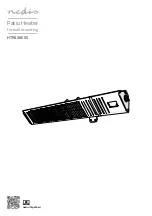
28
INSTALLATION INSTRUCTIONS
Standards Compliance
This water heater must be installed in accordance with
these instructions, local codes, and utility company
requirements.
In the United States where local codes are not
available, use the latest edition of the American
National Standard/National Fuel Gas Code. A copy of
the Fuel Gas Code can be purchased from either the
American Gas Association, 400 North Capitol Street
Northwest, Washington, DC 20001, as ANSI standard
Z223.1, or National Fire Protection Association, 1
Batterymarch Park, MA 02269 as NFPA 54.
In Canada, use the latest edition of the CAN/CSA
B149.1 Natural Gas and Propane Installation Code and
the Canadian Electrical Code, CAN/CSA C22.1, Part 1.
A copy can be purchased from; Canadian Standards
Association, 5060 Spectrum Way, Mississauga, ON
L4W 5N6
Choosing a Location
WARNING:
Fire Hazard –Combustible construction refers to adjacent
walls and ceilings and should not be confused with
combustible or flammable products and materials.
Combustible materials, such as clothing, cleaning
materials, or flammable liquids, must not be placed against
or next to the water heater. Fire or explosion could occur
causing death, personal injury, and/or product damage.
A gas-fired water heater should never be installed in a
space or room where liquids with flammable vapors are
used or stored. Such liquids include gasoline, LP gas
(butane or propane), paint, adhesives and their thinners,
solvents, or removers. Flammable vapors carry long
distances from where they are used or stored. The open
flame of the water heater’s main burner can ignite these
vapors causing an explosion or fire.
NOTICE:
Elevating a gas-fired water heater will reduce but NOT
eliminate the possibility of lighting the vapor of flammable
liquids which may be improperly stored or accidentally
spilled.
NOTICE:
DO NOT connect power until venting installation is complete
(see Venting installation pages 34-46).
NOTICE:
This water heater should not be located in an area where
water leakage of the heat exchanger or connections will
result in damage to the area adjacent to it or to lower floors
of the structures. When such areas cannot be avoided,
install a suitable catch pan with an adequate drain under
the water heater.
The following requirements will ensure a safe
installation:
• The water heater must be located in an area where it
won’t sustain damage from moving vehicles, flooding,
etc. If the water heater is installed in a storage garage,
the direct ignition system and main burner should be
no less than 18 in. (45 cm) above the garage floor.
• If the water heater is installed in a repair garage or in
a private garage, the direct ignition system and main
burner should be no less than 4.5 ft (1400 mm) above
the garage floor.
• The water heater should be installed as close as
possible to the vent exhaust and air intake. This
minimizes the vent length and the number of elbows
and joints required for venting.
• The water heater should be installed with the correct
venting and exhaust materials. See page 34.
General
Exhaust Vent Pipe
Air Intake Pipe
0" min.
(0 mm)
12"
(300 mm)
To Suitable Drain
Condensate
Drain
Upward Slope
to Termination
Condensate
Trap
Approximately 1"
recommended
Summary of Contents for RTGH-84DVLN-2
Page 27: ...INSTALLATION INSTRUCTIONS FOR THE CONTRACTOR 27 Installation ...
Page 58: ...58 INSTALLATION INSTRUCTIONS Wiring Diagram Electrical ...
Page 80: ...80 NOTES ...
Page 81: ...81 NOTES ...
Page 82: ...82 NOTES ...
















































